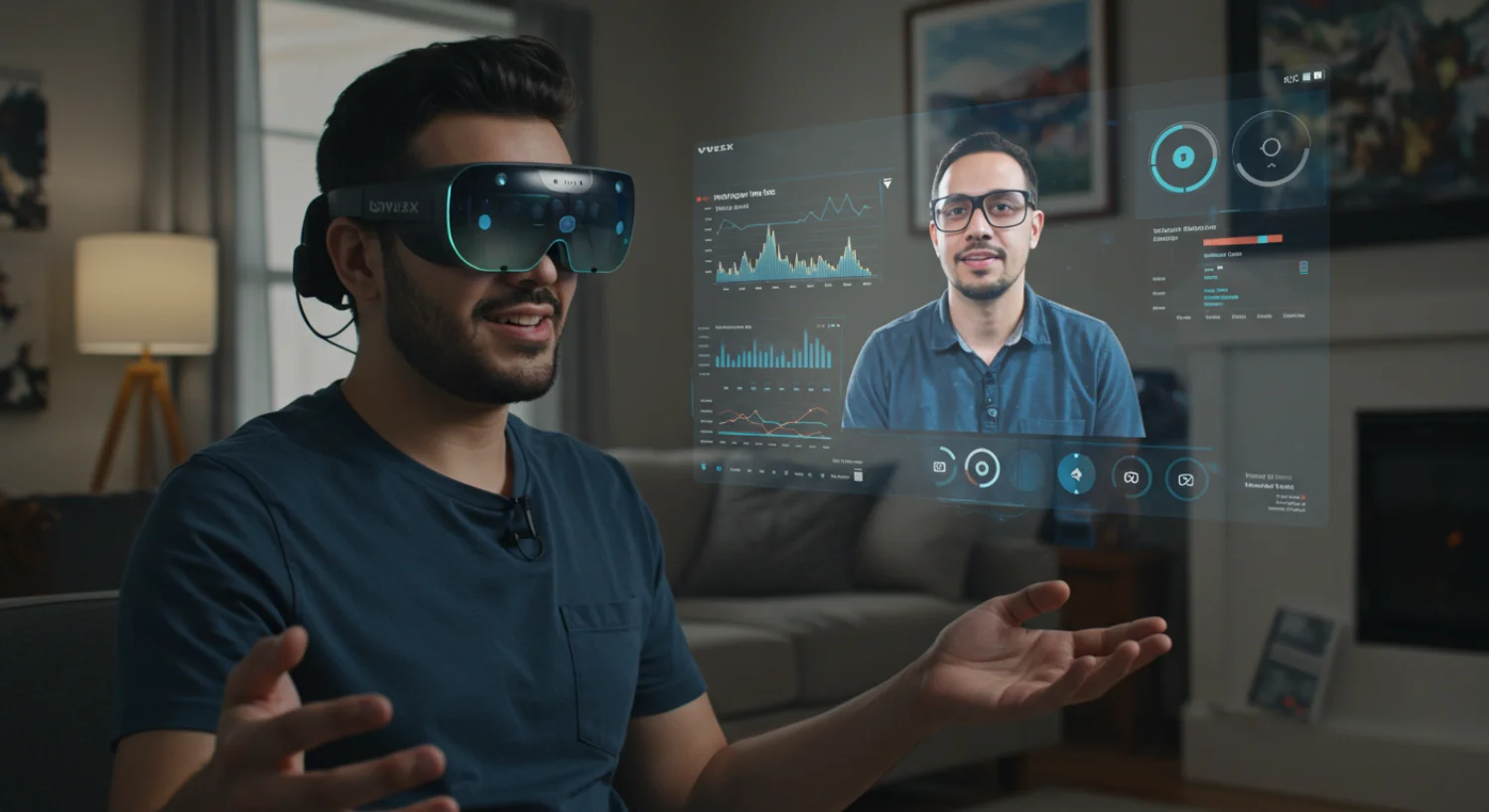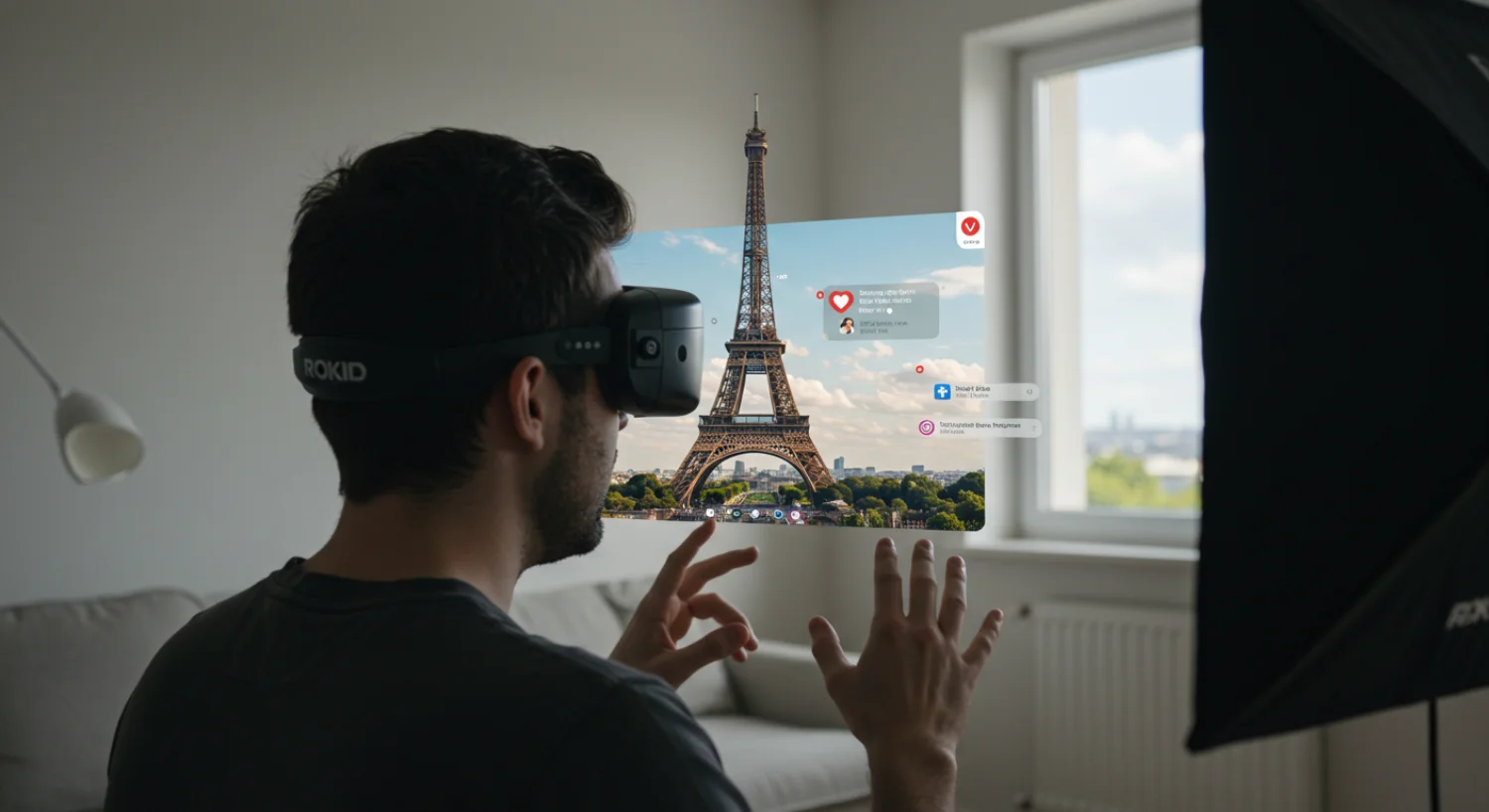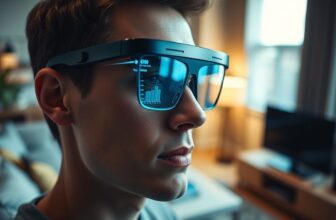AR glasses for streaming are rapidly changing how content creators work. Offering immersive viewing experiences and hands-free operation, these devices are becoming essential tools for live broadcasting, gaming, and more. This guide explores the best options available in 2025, helping you find the perfect pair for your streaming needs.
Understanding AR Technology & Streaming Applications
Augmented reality (AR) is rapidly evolving beyond a futuristic concept and becoming a practical tool for content creators, particularly in the realm of live streaming. Unlike virtual reality (VR), which immerses users in a completely digital environment, AR overlays digital information onto the real world. Think of Pokémon Go, or the filters you use on social media – these are examples of AR in action. This key difference makes AR uniquely suited for streaming, allowing creators to interact with their audience and environment simultaneously.
The core of any AR experience, and therefore of effective AR glasses for streaming, lies in its underlying technology. AR glasses rely on three primary components: displays, sensors, and processors. Displays, typically micro-OLED or micro-LED, project the digital imagery onto the user’s field of view. Sensors, including cameras, depth sensors, and inertial measurement units (IMUs), track the user’s head movements and the surrounding environment, enabling accurate placement of virtual objects. Finally, a powerful processor is needed to handle the complex computations required for real-time tracking and rendering.
Caption: Relative impact of key components on overall AR performance.
The applications of AR glasses are expanding rapidly. Beyond gaming, which is a significant driver of adoption, AR is finding its niche in live streaming, content creation, and remote collaboration. Streamers can use AR to display real-time data, interact with chat messages directly in their field of view, or even incorporate virtual elements into their streams. Vloggers and tutorial creators can benefit from hands-free operation, allowing them to demonstrate tasks without needing to hold a camera or phone. Remote collaboration is enhanced through shared AR experiences, where participants can view and interact with the same virtual objects in a real-world context.
The benefits of using AR for streaming are numerous. Enhanced viewer engagement is a major draw, as interactive displays and unique perspectives capture attention. Hands-free operation frees up the streamer to focus on their content. And the ability to present information in a visually compelling and contextualized manner can significantly improve the overall viewing experience. However, current limitations remain. Battery life is often a concern, with many AR glasses offering only a few hours of use. Field of view (FOV) can be restricted, limiting the immersive quality. And, of course, the cost of entry can be substantial.
Looking ahead to 2025, several up-and-coming technologies promise to address these limitations. Advancements in battery technology, including solid-state batteries, are expected to significantly increase battery life. New display technologies, such as holographic waveguides, are pushing the boundaries of FOV and image quality. And the development of more efficient processors will enable more complex AR experiences. We’re also seeing increased integration of AI and machine learning, which will allow AR glasses to better understand and respond to the user’s environment and intentions. Expect to see more lightweight designs and improved ergonomics as well.
Rokid Max Review (Early 2024)
- Excellent display clarity
- Comfortable for extended use
- Limited app ecosystem
The future of streaming is undoubtedly intertwined with the evolution of AR technology. As AR glasses become more powerful, affordable, and user-friendly, they will become an increasingly essential tool for content creators looking to stand out in a crowded digital landscape.
PROS
- Enhanced viewer engagement
- Hands-free operation
- Unique streaming perspectives
- Improved remote collaboration
CONS
- Limited battery life
- Restricted field of view
- High cost
- Potential for eye strain

Top AR Glasses for Live Gaming Streams
The demand for immersive live streaming experiences is skyrocketing, and AR glasses for streaming are quickly becoming essential tools for gamers. These devices offer a unique perspective, allowing viewers to see the game through the streamer’s eyes, augmented with real-time information and potentially even the streamer’s reactions. But with a growing market, choosing the right pair can be daunting. This chapter details the best AR glasses currently available for gamers wanting to live stream their gameplay, analyzing their strengths and weaknesses.
XREAL Air 2 Pro
The XREAL Air 2 Pro consistently ranks as a top contender. These glasses boast a resolution of 1920×1080 per eye, a 43° field of view (FOV), and a 90Hz refresh rate. Weighing in at just 65g, they’re remarkably comfortable for extended use. Battery life is around 3-4 hours, and connectivity includes USB-C. Pricing starts around $449. Performance is excellent across various genres, from fast-paced FPS titles like *Apex Legends* to immersive RPGs like *Elden Ring*. The clarity and responsiveness make for a compelling streaming experience.
XREAL Air 2 Pro Review
- Excellent visual clarity
- Lightweight and comfortable
- Good compatibility with streaming software
- Slightly limited FOV
PROS
- Comfortable for long sessions
- Easy setup and use
- Good color accuracy
- Supports virtual screens for multitasking
CONS
- FOV could be wider
- Battery life is moderate
- Price is relatively high
- Limited built-in speakers
Rokid Max
Rokid Max takes a different approach, offering a wider 60° FOV and a higher resolution of 2560×2560 per eye. The refresh rate is 90Hz, and the glasses weigh 200g. Battery life is around 2-3 hours. Priced around $549, they’re a premium option. Rokid Max excels in strategy games like *StarCraft II*, where the wider FOV provides a significant advantage. However, the increased weight can be noticeable during prolonged gaming sessions. Compatibility with OBS Studio and Streamlabs Desktop is generally good, but some users have reported minor configuration issues.
Magic Leap 2
While originally targeted at enterprise applications, the Magic Leap 2 can be adapted for gaming and streaming. It features a resolution of 1920×1080 per eye, a 50° FOV, and a 75Hz refresh rate. Weighing 330g, it’s the heaviest of the bunch. Battery life is around 3.5 hours with the external battery pack. The price is a significant barrier, starting at $3299. Despite its high cost, the Magic Leap 2 offers advanced spatial computing capabilities and precise motion tracking, making it suitable for AR experiences that go beyond simply displaying the game on a virtual screen. However, the weight and price make it a niche choice for most streamers.
Caption: Comparison of Field of View across different AR glasses models.
Vuzix Shield
The Vuzix Shield offers a 1920×1080 resolution per eye, a 52° FOV, and a 60Hz refresh rate. It weighs 135g and provides around 2-3 hours of battery life. Priced around $1000, it’s a mid-range option. The Vuzix Shield is known for its robust build quality and enterprise-grade features, but it can feel bulky compared to the XREAL Air 2 Pro. It performs adequately in most gaming scenarios, but the lower refresh rate may be noticeable in fast-paced games.
Lynx DigiLens One
The Lynx DigiLens One is a more affordable option, priced around $599. It offers a resolution of 1920×1080 per eye, a 60° FOV, and a 60Hz refresh rate. Weighing 230g, it’s heavier than the XREAL Air 2 Pro but lighter than the Magic Leap 2. Battery life is around 2-3 hours. While it doesn’t match the visual fidelity of the higher-end models, it provides a solid AR experience for casual streaming and gaming.
Ultimately, the best AR glasses for streaming depend on your budget, priorities, and the types of games you play. For most gamers, the XREAL Air 2 Pro offers the best balance of comfort, visual quality, and price. However, if a wider FOV is crucial, the Rokid Max is a compelling alternative. As the technology matures, we can expect to see even more innovative AR glasses emerge, further enhancing the live streaming experience.
| Feature | XREAL Air 2 Pro | Rokid Max |
|---|---|---|
| Resolution (per eye) | 1920×1080 | 2560×2560 |
| Field of View | 43° | 60° |
| Weight | 65g | 200g |
| Price | $449 | $549 |
The potential of AR glasses for streaming extends far beyond the realm of gaming. While gaming streams have been the initial proving ground, content creators across diverse fields are beginning to explore the unique opportunities augmented reality presents. Vloggers, artists, educators, and performers are all finding innovative ways to leverage AR to produce more engaging, interactive, and immersive streams.

Beyond Gaming: AR Glasses for Creative Streaming
One of the most compelling applications is the creation of virtual studio setups. Instead of relying on green screens or physical sets, streamers can use AR glasses to overlay dynamic backgrounds, graphics, and effects onto their real-world environment. This allows for greater flexibility and cost-effectiveness, particularly for creators working with limited space or budgets. Imagine a travel vlogger broadcasting from their living room, but with a stunning virtual backdrop of the Eiffel Tower seamlessly integrated into the scene.
Augmented reality tutorials are another exciting use case. Instructors can use AR glasses to overlay instructions, diagrams, and 3D models onto the real world, guiding viewers through complex tasks in a visually intuitive way. A mechanic, for example, could demonstrate a car repair with AR annotations highlighting specific parts and steps. This hands-on approach significantly enhances the learning experience.
Caption: A comparison of immersion levels across different streaming technologies.
Remote interviews can also be revolutionized with AR. Guests can appear as holographic projections in the streamer’s environment, creating a more engaging and personal connection with the audience. This is particularly valuable for interviews with experts or personalities who are located in different parts of the world. Furthermore, AR glasses can be used to display live data visualizations during streams, such as stock prices, social media trends, or real-time analytics. This is ideal for financial commentators, news analysts, or anyone who needs to present data in a dynamic and visually appealing way.
Which AR Glasses Are Best for Creative Applications?
The ideal AR glasses for streaming for creative applications differ from those optimized for gaming. Key features include robust hand tracking for interactive elements, high-quality spatial audio for immersive experiences, and seamless software integration with tools like Adobe Creative Suite and Unity.
PROS (XREAL Air 2 Pro)
- Excellent display quality
- Comfortable and lightweight
- Good software support
CONS (XREAL Air 2 Pro)
- Hand tracking is still developing
- Limited native AR app ecosystem
- Price point can be a barrier
The XREAL Air 2 Pro remains a strong contender due to its comfortable design and impressive display. Rokid Max offers a wider field of view, beneficial for immersive virtual studio setups. Magic Leap 2, while significantly more expensive, provides superior hand tracking and spatial computing capabilities, making it ideal for complex AR interactions. For displaying data, the clarity of the XREAL Air 2 Pro is often preferred.
Successful creative streams utilizing AR glasses are already emerging. Artists are using AR to create virtual sculptures and paintings in real-time, while educators are delivering interactive lessons with AR-enhanced textbooks. Storytellers are crafting immersive narratives where AR elements blend seamlessly with the real world, captivating audiences in entirely new ways.
As AR technology continues to evolve, we can expect to see even more innovative applications emerge, further blurring the lines between the physical and digital worlds and transforming the landscape of live content creation.

Setting Up & Optimizing AR Glasses for Streaming Success
Once you’ve chosen your AR glasses for streaming, the real work begins: getting them properly configured for a smooth, high-quality broadcast. This isn’t a plug-and-play experience; optimization is key. The initial setup involves connecting the glasses to your streaming rig – typically a computer, but increasingly, high-end mobile devices are viable options. Connection methods vary, ranging from USB-C to Wi-Fi 6E, with the latter offering lower latency but requiring a stable network.
Calibration is the next crucial step. Most AR glasses require display calibration to ensure the virtual elements align correctly with your real-world view. This usually involves following on-screen prompts, adjusting interpupillary distance (IPD), and potentially fine-tuning the display’s position and angle. Accurate calibration minimizes eye strain and maximizes the immersive experience for your viewers. Don’t skip this!
Configuring your streaming software (OBS Studio, Streamlabs Desktop, etc.) to recognize and utilize the AR glasses’ feed is paramount. This often involves selecting the AR glasses as a video capture device. You may need to install specific drivers or plugins provided by the manufacturer. Experiment with different capture modes – passthrough, mixed reality, or virtual screen – to find what best suits your content.
Caption: Comparison of average latency between popular AR glasses models.
Optimizing settings for performance and visual quality is an iterative process. Lowering the resolution or graphics settings within the AR glasses’ software can reduce latency and improve frame rates, especially on less powerful computers. Experiment with different bitrates and encoding settings in your streaming software to find the sweet spot between visual fidelity and stream stability.
Troubleshooting is inevitable. Common issues include latency (delay between your actions and what viewers see), display flickering, and audio problems. Latency can often be reduced by using a wired connection, optimizing network settings, and lowering graphics settings. Flickering may indicate driver issues or compatibility problems. Audio issues can usually be resolved by ensuring the correct audio input device is selected in your streaming software and adjusting volume levels.
Minimizing eye strain during long streaming sessions is critical. Take frequent breaks, adjust the brightness and contrast of the display, and ensure the glasses fit comfortably. Consider using a head strap or facial interface to distribute the weight more evenly and improve comfort. Proper lighting is also essential; avoid glare and ensure sufficient ambient light to reduce eye fatigue.
PROS of Optimized Setup
- Reduced Eye Strain
- Improved Stream Quality
- Lower Latency
- Enhanced Viewer Experience
CONS of Complex Setup
- Requires Technical Knowledge
- Can Be Time-Consuming
- Potential Compatibility Issues
A high-quality microphone setup is crucial to complement the AR experience. Viewers need to hear you clearly. Consider using a dedicated USB microphone or a headset with a noise-canceling microphone. Position the microphone close to your mouth but out of the field of view of the AR glasses.
Looking ahead to 2025, we can expect improvements in AR glasses focusing on lighter designs, wider fields of view, and more powerful processors. New models are slated to feature advanced eye-tracking and hand-tracking capabilities, enabling even more immersive and interactive streaming experiences. Resources like Reddit’s r/ARGlasses and dedicated Discord servers offer valuable communities and support for troubleshooting and sharing best practices. Finding the right community can be invaluable when navigating the world of AR glasses for streaming.
XREAL Beam 2 Pro Evaluation
- Excellent portability
- Low Latency
- Seamless integration with XREAL Air 2 Pro
- Slightly expensive
Ultimately, the best AR glasses for streaming depend on your specific requirements and budget. From enhanced immersion to increased productivity, these devices offer a unique edge. As technology evolves in 2025 and beyond, AR glasses for streaming will become even more sophisticated, so stay informed and choose wisely. What are your thoughts on the future of AR in live content creation?





